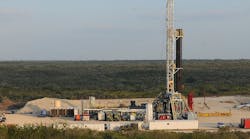An OGJ Special Report issue that contains a wrapup on the deepwater Gulf of Mexico might seem an unlikely place for a column about natural gas in the Rocky Mountains.
But if US gas consumption is to grow from 22 tcf/year now to 30 tcf by 2010 and 40 tcf by 2020, the country needs more gas from whatever sources it can.
The US Geological Survey estimated that two thirds of future US undiscovered gas will come from onshore and one third from offshore. That's 200 tcf onshore vs. 100 tcf offshore.
Much of the onshore supply will come from Rocky Mountain basins, where huge stores of gas in rock of extremely low permeability line deep sedimentary layers of many of the Laramide-age basins. These deposits have been called basin-centered, deep-basin, and continuous-type accumulations in the literature.
Said Colorado School of Mines geologist Fred F. Meissner: "The Rocky Mountains are a Persian Gulf of gas."
These deposits are in unconventional geologic settings. Their geologic characteristics vary. And they will require unconventional thinking, exploration tools, and completion techniques to exploit.
Basin-centered gas
Concepts and ideas about basin-centered gas are at least 30-40 years old.
About 500 geologists meeting in Denver in October heard reports that exploitation of deep-basin gas is still at an early stage relative to exploration for conventional gas in anticlinal and stratigraphic buoyancy traps.
The Rocky Mountain Association of Geologists organized the meeting.
Production records do not differentiate deep-basin gas, but perhaps 15% of US gas production originates in basin-centered gas fields, estimated Ben E. Law, a geologist retired from the USGS and the meeting's champion. This would be the largest share of US gas provided by any single category of unconventional reservoirs.
Basin-centered gas deposits of varying prospectivity lie in most Lower 48 and Alaskan basins. Important ones in the Rockies are in the Green River, Piceance, San Juan, and Wind River basins. A few fields, such as giant Altamont-Bluebell in Utah, also contain oil.
One day the entire bottom of the Green River basin will be colored red on a production map, Meissner opined. New trap classifications are needed to account for the existence of anomalously pressured, dynamic hydrocarbon accumulations in unsealed regional synclinal positions.
Geologic factors
Deep-basin gas deposits are generally thermal gas in sandstones of Cretaceous age, are overpressured or underpressured, and are found downdip of water in synclines or on basin flanks, Law said.
The deposits are large to extraordinarily large, and wells require frac jobs for commercial production, said John Masters, an eminent geologist instrumental in discovery of one such field, supergiant Elmworth in Alberta.
Law listed as common attributes areas of hundreds to thousands of square kilometers, single or stacked reservoirs several thousand kilometers thick, abnormal pressure, with interbedded water-bearing reservoirs but generally no downdip water contact.
For example, Lee F. Krystinik of Krystinik Litho-Logic, Fort Worth, described the mid-Cretaceous Frontier formation in the Green River basin as having 10-12% porosity and 0.0001 md in situ permeability. It is intensely fractured but contains unfractured gaps and pressure cells with different pressure histories.
Converting the resources into reserves will be particularly expensive and difficult, said Ronald C. Surdam and other authors from the University of Wyoming-Laramie.
Surdam said that when velocity characteristics are integrated with seismic amplitude attributes, trace to trace continuities, and reservoir modeling, commonly it is possible to evaluate most of the important exploration aspects of anomalously pressured systems. The concepts have been tested successfully in 26 world basins, he said.
Exploration approach
Known deep-basin fields have been found largely by luck and less due to scientific exploration, Masters said.
On the other hand, he urged the geologists not to confuse science with exploration with regard to deep-basin geologic inconsistencies: "You have got to move without all the answers."
Masters was afraid at first to believe gas could be found downdip from water, but in the 1970s he published a prediction that more gas would be found in low permeability reservoirs than in high permeability ones.
Just as in mining geology, geologists chasing deep-basin deposits should harbor "no expectation of consistency," Masters said.
"The largest, most prolific, most profitable opportunity in the onshore US is evaluating other companies' mistakes," Masters said. The Elmworth discovery in 1976 stemmed from evaluation of 85 bypassed dry holes along a 140-mile trend and resulted in a gas accumulation that covers roughly 5,000 sq miles with water above and below the gas.
"True exploration competency in the new basin-centered fields will require more flexibility than did the previous procedures related to buoyant traps. The results will revolutionize hydrocarbon exploration in the US and confound the major companies who saw no further value in the onshore," he concluded.

